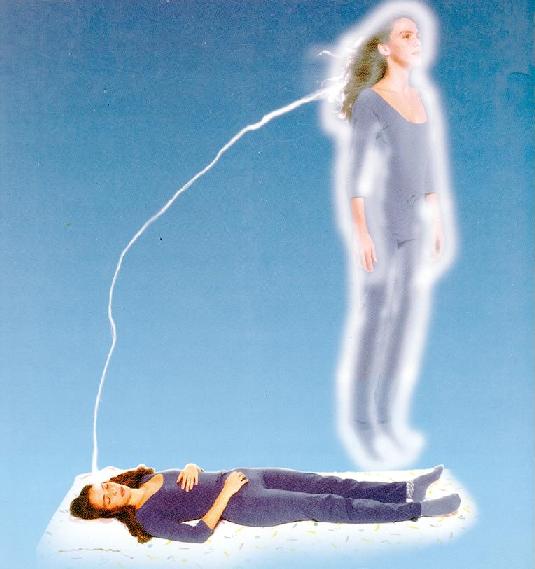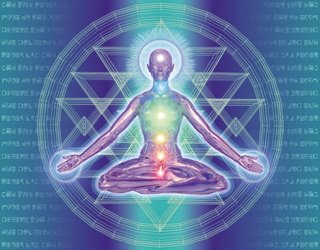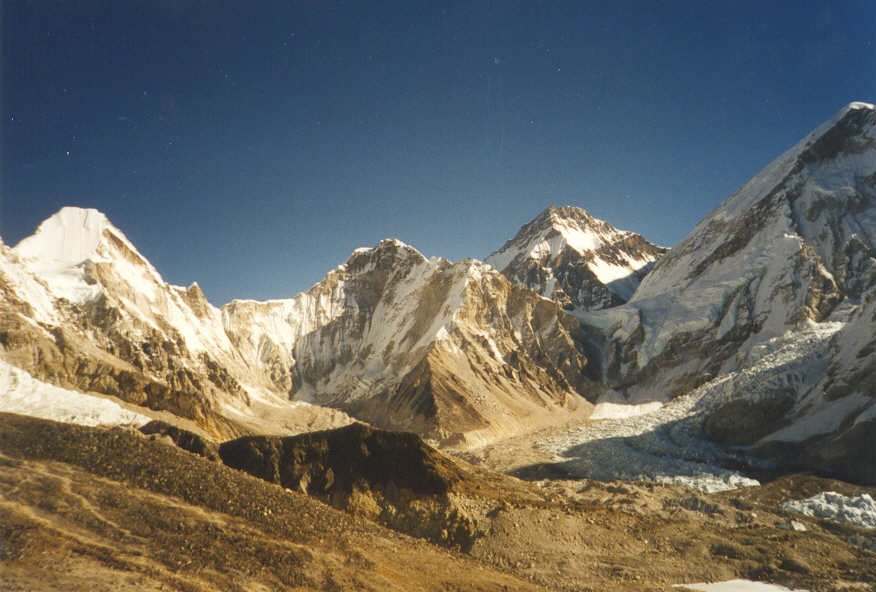






An out-of-body experience (OBE or sometimes OOBE) is an experience that typically involves a sensation of floating outside of one's body and, in some cases, perceiving one's physical body from a place outside one's body.
Some researchers have managed to recreate OBE in a laboratory setup by stimulating a part in the human brain. One in ten people has an out-of-body experience once or more commonly several times in their life. OBEs are often part of the near-death experience. Those who have experienced OBEs sometimes claim to have observed details which were unknown to them beforehand.
In some cases the phenomenon appears to occur spontaneously; in others it is associated with a physical or mental trauma, use of psychedelic drugs, dissociative drugs, or a dream-like state. Many techniques aiming to induce the experience deliberately have been developed, for example visualization while in a relaxed, meditative state.
Recent studies have shown that experiences somewhat similar to OBEs can be induced by direct brain stimulation. Some of those who experience OBEs claimed to have willed themselves out of their bodies, while others report having found themselves being pulled from their bodies (usually preceded by a feeling of paralysis). In other accounts, the feeling of being outside the body was suddenly realized after the fact, and the experiencers saw their own bodies almost by accident. OBEs often occur during the borderline stage between REM sleep and arousal when sleep paralysis may persist and dream imagery may mingle with sensory input.
Some neurologists have suspected that the event is triggered by a mismatch between visual and tactile signals. They used a virtual reality setup to recreate an OBE. The subject looked through goggles and saw his own body as it would appear to an outside observer standing behind him. The experimenter then touched the subject at the same time as a rod appeared to touch the virtual image. The experiment created an illusion of being behind and outside one's body. However, both critics and the experimenter himself note that the study fell short of replicating "full-blown" OBEs
Some researchers have managed to recreate OBE in a laboratory setup by stimulating a part in the human brain. One in ten people has an out-of-body experience once or more commonly several times in their life. OBEs are often part of the near-death experience. Those who have experienced OBEs sometimes claim to have observed details which were unknown to them beforehand.
In some cases the phenomenon appears to occur spontaneously; in others it is associated with a physical or mental trauma, use of psychedelic drugs, dissociative drugs, or a dream-like state. Many techniques aiming to induce the experience deliberately have been developed, for example visualization while in a relaxed, meditative state.
Recent studies have shown that experiences somewhat similar to OBEs can be induced by direct brain stimulation. Some of those who experience OBEs claimed to have willed themselves out of their bodies, while others report having found themselves being pulled from their bodies (usually preceded by a feeling of paralysis). In other accounts, the feeling of being outside the body was suddenly realized after the fact, and the experiencers saw their own bodies almost by accident. OBEs often occur during the borderline stage between REM sleep and arousal when sleep paralysis may persist and dream imagery may mingle with sensory input.
Some neurologists have suspected that the event is triggered by a mismatch between visual and tactile signals. They used a virtual reality setup to recreate an OBE. The subject looked through goggles and saw his own body as it would appear to an outside observer standing behind him. The experimenter then touched the subject at the same time as a rod appeared to touch the virtual image. The experiment created an illusion of being behind and outside one's body. However, both critics and the experimenter himself note that the study fell short of replicating "full-blown" OBEs
The Himalaya Range (Sanskrit: literally, "abode of snow"), the Himalayas or Himalaya for short, is a mountain range in Asia, separating the Indian subcontinent from the Tibetan Plateau. By extension, it is also the name of a massive mountain system that includes the Karakoram, the Hindu Kush, and other, lesser, ranges that extend out from the Pamir Knot.
Together, the Himalayan mountain system is the planet's highest, and home to the world's highest peaks, the Eight-thousanders, which include Mount Everest and K2. To comprehend the enormous scale of this mountain range, consider that Aconcagua, in the Andes, at 6,962 metres (22,841 ft) is the highest peak outside Asia, whereas the Himalayan system includes over 100 mountains exceeding 7,200 m (23,622 ft).
Some of the world's major rivers, the Ganges, Indus, Brahmaputra, Yangtze, Mekong, Salween, Red River (Asia), Xunjiang, Chao Phraya, Irrawaddy River, Amu Darya, Syr Darya, Tarim River and Yellow River, rise in the Himalayas, and their combined drainage basin is home to some 3 billion people (almost half of Earth's population) in Afghanistan, Bangladesh, Bhutan, People's Republic of China, India, Nepal, Burma, Cambodia, Tajikistan, Uzbekistan, Turkmenistan, Kazakhstan, Kyrgyzstan, Thailand, Laos, Vietnam, Malaysia and Pakistan.
The Himalayas have profoundly shaped the cultures of South Asia; many Himalayan peaks are sacred in Hinduism, Buddhism and Sikhism. The main Himalaya range runs west to east, from the Indus river valley to the Brahmaputra river valley, forming an arc 2,400 km (1,491 mi) long, which varies in width from 400 km (249 mi) in the western Kashmir-Xinjiang region to 150 km (93 mi) in the eastern Tibet-Arunachal Pradesh region. The range consists of three coextensive sub-ranges, with the northernmost, and highest, known as the Great or Inner Himalayas.
Together, the Himalayan mountain system is the planet's highest, and home to the world's highest peaks, the Eight-thousanders, which include Mount Everest and K2. To comprehend the enormous scale of this mountain range, consider that Aconcagua, in the Andes, at 6,962 metres (22,841 ft) is the highest peak outside Asia, whereas the Himalayan system includes over 100 mountains exceeding 7,200 m (23,622 ft).
Some of the world's major rivers, the Ganges, Indus, Brahmaputra, Yangtze, Mekong, Salween, Red River (Asia), Xunjiang, Chao Phraya, Irrawaddy River, Amu Darya, Syr Darya, Tarim River and Yellow River, rise in the Himalayas, and their combined drainage basin is home to some 3 billion people (almost half of Earth's population) in Afghanistan, Bangladesh, Bhutan, People's Republic of China, India, Nepal, Burma, Cambodia, Tajikistan, Uzbekistan, Turkmenistan, Kazakhstan, Kyrgyzstan, Thailand, Laos, Vietnam, Malaysia and Pakistan.
The Himalayas have profoundly shaped the cultures of South Asia; many Himalayan peaks are sacred in Hinduism, Buddhism and Sikhism. The main Himalaya range runs west to east, from the Indus river valley to the Brahmaputra river valley, forming an arc 2,400 km (1,491 mi) long, which varies in width from 400 km (249 mi) in the western Kashmir-Xinjiang region to 150 km (93 mi) in the eastern Tibet-Arunachal Pradesh region. The range consists of three coextensive sub-ranges, with the northernmost, and highest, known as the Great or Inner Himalayas.
Time is a part of the measuring system used to sequence events, to compare the durations of events and the intervals between them, and to quantify rates of change such as the motions of objects. Time has been a major subject of religion, philosophy, and science, but defining it in a non-controversial manner applicable to all fields of study has consistently eluded the greatest scholars.
Time is one of the seven fundamental physical quantities in the International System of Units. Time is used to define other quantities — such as velocity — so defining time in terms of such quantities would result in circularity of definition. An operational definition of time, wherein one says that observing a certain number of repetitions of one or another standard cyclical event (such as the passage of a free-swinging pendulum) constitutes one standard unit such as the second, is highly useful in the conduct of both advanced experiments and everyday affairs of life. The operational definition leaves aside the question whether there is something called time, apart from the counting activity just mentioned, that flows and that can be measured. Investigations of a single continuum called spacetime bring questions about space into questions about time, questions that have their roots in the works of early students of natural philosophy.
Among prominent philosophers, there are two distinct viewpoints on time. One view is that time is part of the fundamental structure of the universe, a dimension in which events occur in sequence. Sir Isaac Newton subscribed to this realist view, and hence it is sometimes referred to as Newtonian time. Time travel, in this view, becomes a possibility as other "times" persist like frames of a film strip, spread out across the time line. The opposing view is that time does not refer to any kind of "container" that events and objects "move through", nor to any entity that "flows", but that it is instead part of a fundamental intellectual structure (together with space and number) within which humans sequence and compare events. This second view, in the tradition of Gottfried Leibniz and Immanuel Kant, holds that time is neither an event nor a thing, and thus is not itself measurable nor can it be travelled.
Time is one of the seven fundamental physical quantities in the International System of Units. Time is used to define other quantities — such as velocity — so defining time in terms of such quantities would result in circularity of definition. An operational definition of time, wherein one says that observing a certain number of repetitions of one or another standard cyclical event (such as the passage of a free-swinging pendulum) constitutes one standard unit such as the second, is highly useful in the conduct of both advanced experiments and everyday affairs of life. The operational definition leaves aside the question whether there is something called time, apart from the counting activity just mentioned, that flows and that can be measured. Investigations of a single continuum called spacetime bring questions about space into questions about time, questions that have their roots in the works of early students of natural philosophy.
Among prominent philosophers, there are two distinct viewpoints on time. One view is that time is part of the fundamental structure of the universe, a dimension in which events occur in sequence. Sir Isaac Newton subscribed to this realist view, and hence it is sometimes referred to as Newtonian time. Time travel, in this view, becomes a possibility as other "times" persist like frames of a film strip, spread out across the time line. The opposing view is that time does not refer to any kind of "container" that events and objects "move through", nor to any entity that "flows", but that it is instead part of a fundamental intellectual structure (together with space and number) within which humans sequence and compare events. This second view, in the tradition of Gottfried Leibniz and Immanuel Kant, holds that time is neither an event nor a thing, and thus is not itself measurable nor can it be travelled.
Love is the emotion of strong affection and personal attachment. In philosophical context, love is a virtue representing all of human kindness, compassion, and affection. In some religious contexts, love is not just a virtue, but the basis for all being, as in the Roman Catholic phrase, "God is love". Love may also be described as actions towards others (or oneself) based on compassion. Or as actions towards others based on affection.
The word love can refer to a variety of different feelings, states, and attitudes, ranging from generic pleasure ("I loved that meal") to intense interpersonal attraction ("I love my partner"). "Love" can also refer specifically to the passionate desire and intimacy of romantic love, to the sexual love of eros (cf. Greek words for love), to the emotional closeness of familial love, or to the platonic love that defines friendship, to the profound oneness or devotion of religious love. This diversity of uses and meanings, combined with the complexity of the feelings involved, makes love unusually difficult to consistently define, even compared to other emotional states.
Love in its various forms acts as a major facilitator of interpersonal relationships and, owing to its central psychological importance, is one of the most common themes in the creative arts. The word "love" can have a variety of related but distinct meanings in different contexts. Often, other languages use multiple words to express some of the different concepts that English relies mainly on "love" to encapsulate; one example is the plurality of Greek words for "love." Cultural differences in conceptualizing love thus make it doubly difficult to establish any universal definition.
Although the nature or essence of love is a subject of frequent debate, different aspects of the word can be clarified by determining what isn't love. As a general expression of positive sentiment (a stronger form of like), love is commonly contrasted with hate (or neutral apathy); as a less sexual and more emotionally intimate form of romantic attachment, love is commonly contrasted with lust; and as an interpersonal relationship with romantic overtones, love is sometimes contrasted with friendship, although the word love is often applied to close friendships.
The word love can refer to a variety of different feelings, states, and attitudes, ranging from generic pleasure ("I loved that meal") to intense interpersonal attraction ("I love my partner"). "Love" can also refer specifically to the passionate desire and intimacy of romantic love, to the sexual love of eros (cf. Greek words for love), to the emotional closeness of familial love, or to the platonic love that defines friendship, to the profound oneness or devotion of religious love. This diversity of uses and meanings, combined with the complexity of the feelings involved, makes love unusually difficult to consistently define, even compared to other emotional states.
Love in its various forms acts as a major facilitator of interpersonal relationships and, owing to its central psychological importance, is one of the most common themes in the creative arts. The word "love" can have a variety of related but distinct meanings in different contexts. Often, other languages use multiple words to express some of the different concepts that English relies mainly on "love" to encapsulate; one example is the plurality of Greek words for "love." Cultural differences in conceptualizing love thus make it doubly difficult to establish any universal definition.
Although the nature or essence of love is a subject of frequent debate, different aspects of the word can be clarified by determining what isn't love. As a general expression of positive sentiment (a stronger form of like), love is commonly contrasted with hate (or neutral apathy); as a less sexual and more emotionally intimate form of romantic attachment, love is commonly contrasted with lust; and as an interpersonal relationship with romantic overtones, love is sometimes contrasted with friendship, although the word love is often applied to close friendships.
Mechanic of Mind Your emotions, your sentiments, your thoughts - the whole paraphernalia of the mind - are manipulated by the outside. Scientifically, it has become more clear now, but even without scientific investigation the mystics have been saying exactly the same thing for thousands of years - that all these things your mind is filled with are not yours; you are beyond them. You get identified with them, and that's the only problem.
For example, somebody insults you and you become angry. You think you are becoming angry, but scientifically speaking the other person's insult is only functioning as a remote control. The person who has insulted you is managing your behavior. Your anger is in his hands; you are behaving like a puppet. Now scientists are able to put electrodes in the brain at certain centers, and it is almost unbelievable. The mystics have been talking about it for thousands of years, but only recently has science discovered that there are hundreds of centers in the brain controlling all your behavior. An electrode can be put at a particular center - for example, the center for anger. Nobody insults you, nobody humiliates you, nobody says anything to you; you are sitting silently, happily, and somebody pushes a button on a remote control and you become angry! It is a very strange feeling because you cannot see the reason anywhere, why you are becoming angry. Perhaps you will rationalize it somehow. You see a man passing by in the hallway and you remember that he insulted you - you will find some rationalization just to console yourself that you are not going mad. Sitting silently . . . and suddenly feeling so angry without any provocation?
And the same remote controller can work to make you happy. Sitting in your chair you start giggling, and you look all around - if somebody is watching you he will think you are going crazy! Nobody has said anything, nothing has happened, nobody has slipped on a banana peel, so why are you giggling? You will rationalize it, you will try to find some rational grounds for giggling. And the strangest thing is that the next time the same button is pushed and you giggle, you will again come up with the same rationale, the same consolation, the same explanation - not even the rationalization is yours! It is almost like a gramophone record.
For example, somebody insults you and you become angry. You think you are becoming angry, but scientifically speaking the other person's insult is only functioning as a remote control. The person who has insulted you is managing your behavior. Your anger is in his hands; you are behaving like a puppet. Now scientists are able to put electrodes in the brain at certain centers, and it is almost unbelievable. The mystics have been talking about it for thousands of years, but only recently has science discovered that there are hundreds of centers in the brain controlling all your behavior. An electrode can be put at a particular center - for example, the center for anger. Nobody insults you, nobody humiliates you, nobody says anything to you; you are sitting silently, happily, and somebody pushes a button on a remote control and you become angry! It is a very strange feeling because you cannot see the reason anywhere, why you are becoming angry. Perhaps you will rationalize it somehow. You see a man passing by in the hallway and you remember that he insulted you - you will find some rationalization just to console yourself that you are not going mad. Sitting silently . . . and suddenly feeling so angry without any provocation?
And the same remote controller can work to make you happy. Sitting in your chair you start giggling, and you look all around - if somebody is watching you he will think you are going crazy! Nobody has said anything, nothing has happened, nobody has slipped on a banana peel, so why are you giggling? You will rationalize it, you will try to find some rational grounds for giggling. And the strangest thing is that the next time the same button is pushed and you giggle, you will again come up with the same rationale, the same consolation, the same explanation - not even the rationalization is yours! It is almost like a gramophone record.
WHAT DO WE MEAN BY SAMADHI ? HOW IT DIFFERS FROM SUICIDE ?
Let’s try to find out about these two conditions .
Suicide is defined as act of intentionally killing oneself . It we take this definition in to account then even SAMADHI also falls in the category of self killing . So, in a broader way it is difficult to find the difference between these two . To understand the difference we can just define the conditions under which these two acts take place .
Perhaps , suicide is committed while a SAMADHI is performed. Suicide has material base while SAMADHI is an intentional spiritual end , leaving the physical body behind and liberating the soul in eternal ether medium .
An attempt of self killing is certainly a consequence of failure to ostensibly give an inspiration to conquer the battle of life , which is not true but merely a delusion. Suicide is attempted in an impulse and painful after it is done while SAMADHI is harmonious and satiating to the core of soul .
Suicide is attempted using various ways available to end the life of body while the SAMADHI is attained at will just by the act of meditation .
Suicide certainly means oppression of desires and dreams while SAMADHI means that the soul had attained a state where the material world doesn’t carry any importance for any further refinement .
A success of an attempt to commit suicide leaves the spirit wandering in the lower planes of life after death with the feeling to remain attached to the world giving itself a false hope of fulfilling its material desires .
The astral form remains intact after a suicide while at the state of SAMADHI astral form of the body does not exist and the soul leaves the body and never hovers in lower planes of life after death . It either reincarnates in a spiritual being or gets merged in the eternal form of GOD for forever .
Spiritual attainment of soul in the physical form is certainly a state where the material life is jargon to continue and soul seeks the liberation .
A person who is engaged with this world and emotionally entangled with its activities will surely have mental shambles , he will surely be pushing himself to the suicidal net .
Let’s try to find out about these two conditions .
Suicide is defined as act of intentionally killing oneself . It we take this definition in to account then even SAMADHI also falls in the category of self killing . So, in a broader way it is difficult to find the difference between these two . To understand the difference we can just define the conditions under which these two acts take place .
Perhaps , suicide is committed while a SAMADHI is performed. Suicide has material base while SAMADHI is an intentional spiritual end , leaving the physical body behind and liberating the soul in eternal ether medium .
An attempt of self killing is certainly a consequence of failure to ostensibly give an inspiration to conquer the battle of life , which is not true but merely a delusion. Suicide is attempted in an impulse and painful after it is done while SAMADHI is harmonious and satiating to the core of soul .
Suicide is attempted using various ways available to end the life of body while the SAMADHI is attained at will just by the act of meditation .
Suicide certainly means oppression of desires and dreams while SAMADHI means that the soul had attained a state where the material world doesn’t carry any importance for any further refinement .
A success of an attempt to commit suicide leaves the spirit wandering in the lower planes of life after death with the feeling to remain attached to the world giving itself a false hope of fulfilling its material desires .
The astral form remains intact after a suicide while at the state of SAMADHI astral form of the body does not exist and the soul leaves the body and never hovers in lower planes of life after death . It either reincarnates in a spiritual being or gets merged in the eternal form of GOD for forever .
Spiritual attainment of soul in the physical form is certainly a state where the material life is jargon to continue and soul seeks the liberation .
A person who is engaged with this world and emotionally entangled with its activities will surely have mental shambles , he will surely be pushing himself to the suicidal net .






- Home
- Esoteric
- Environmental Awareness
- Ashram
- Lotus Water Lily
- Rose
- Rare Herbal Plants
- Child & Women Empowerment
- Services
- New & Renewable Energy
- Video Gallery
- Members
- Contact Us
